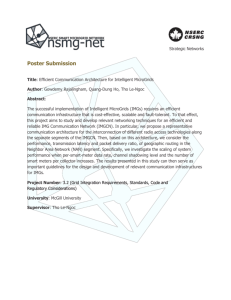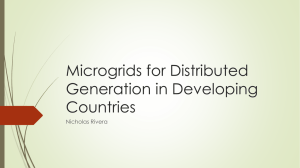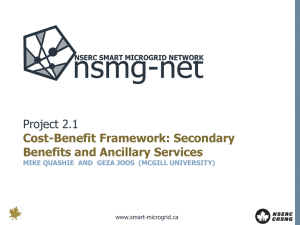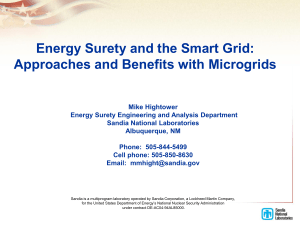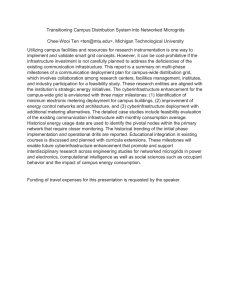Multi-Agent System Transient Stability Platform for Resilient Self-Healing Operation of Multiple Microgrids
advertisement
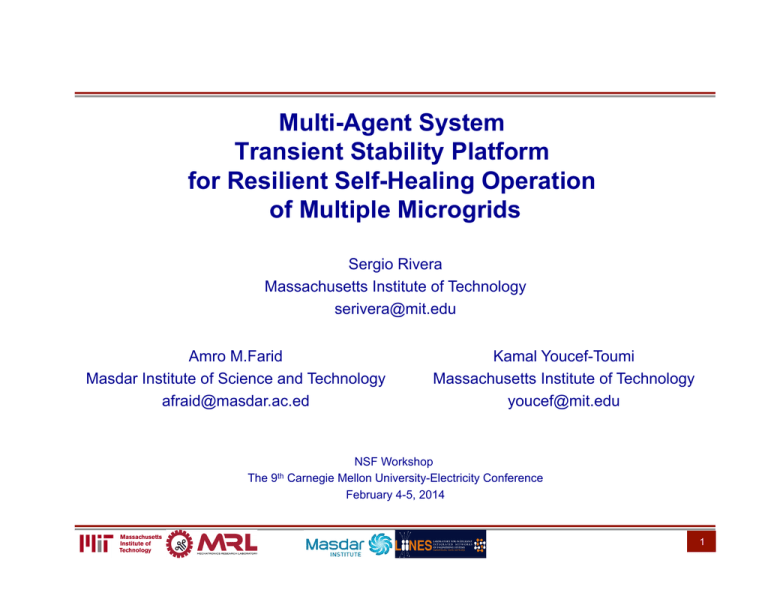
Multi-Agent System Transient Stability Platform for Resilient Self-Healing Operation of Multiple Microgrids Sergio Rivera Massachusetts Institute of Technology serivera@mit.edu Amro M.Farid Masdar Institute of Science and Technology afraid@masdar.ac.ed The 9th Kamal Youcef-Toumi Massachusetts Institute of Technology youcef@mit.edu NSF Workshop Carnegie Mellon University-Electricity Conference February 4-5, 2014 1 Presentation Outline Outline Motivation Coordination & Control of Microgrids Platform Case Study Conclusion § Goals: - Coordination & Control of Microgrids and current research needs. - Multi-Agent System Transient Stability Platform for Resilient Self-Healing Operation of Multiple Microgrids § Outline § Motivation § Approach for Multi-Agent system Coordination & Control of Microgrids § Platform for Multi-Agent System Transient Stability § Case study § Conclusion 2 Power Grids – Present and Future Outline Motivation Coordination & Control of Microgrids Present Power Grid [7A] Platform Case Study Conclusion Power Grid of the Future [8A] Power Grid of the Future integrates: § Meshed-two-way flow in the distribution system § Demand side management § Renewable energy § … ∴ Future Power Grid requires a total “rethink” to its operation! 4 Power Grid Operation with Multiple Stakeholders Outline Motivation Coordination & Control of Microgrids Platform Case Study Conclusion [8A] § Multiple stakeholders & multilateralism: multiple stakeholders should be able to make independent, partially & fully coordinated decisions - Independent power producers - Active demand side participants - Independent microgrids - Co-operating utilities Co-operating nations § Increasing penetration of self-controlled microgrids § Increasing coordination between connected utilities in different countries ∴ Multiple stakeholders require robust & distributed reconfigurable control methods for reliable operation 5 Blackouts Induced by Fault Propagation Outline Motivation Coordination & Control of Microgrids Platform Case Study Conclusion § Sept 8, 2011 Southwest Blackout Event: Operator makes an error in a routine reconfiguration of a capacitor bank. à Disrupts entire western US. ∴ Online reconfiguration can have dramatic effects! 6 Broken Power Grid Conventional Wisdoms Outline Motivation Coordination & Control of Microgrids Wind Power Output Platform Case Study Conclusion Solar Power Output on a Cloudy Day Source: ERCOT 2009 Source: NERC 2009 ∴ Wind Power Output Can Vary Drastically & Suddenly ∴ Solar Output on a Cloudy Day Can Vary Drastically ∴ Variable Behavior of Renewable Energy Resources Stresses the Power Grid 7 MULTI-AGENT SYSTEMS Outline Motivation Coordination & Control of Microgrids Platform Case Study Conclusion A multi-agent system is a computerized system composed of multiple interacting intelligent agents within an environment. Multi-agent systems can be used to solve problems that are difficult or impossible for an individual agent or a monolithic system to solve. § Autonomy/Semi-autonomy § Reactivity § Distributed, Coordinated Decision making [36] 9 MAS - Microgrids Control and Coordination Outline Motivation Coordination & Control of Microgrids Platform Case Study Conclusion • The Distribution network Operator (DNO) refers to the operational functions of the system and the Market Operator (MO) to the Market functions, in the Grid Level. • The MicroGrid Central Controller (MGCC) is the main responsible for the optimization of the MicroGrid operation coordinating the Local Controllers (LC), in the Management Level. • The LC’s control the Distributed Energy Resources (DER), production and storage units, and some of the local loads, in the Field Level. [21]-[25] 10 MAS - Microgrids Control and Coordination Outline Motivation [36] Coordination & Control of Microgrids Platform Case Study Conclusion Current Drawbacks: § Agents have only partial representation of the environments. § No account for the dynamic grid behavior. § No account for Primary, secondary and tertiary control interaction. 11 Multi-Layer Design Principles Outline Motivation Coordination & Control of Microgrids [29A] Platform Case Study Conclusion § Power grids traditionally employ primary, secondary & tertiary control – we study these together rather than independently § We propose an agent layer for complex rule-based decision-making that mimic people and organizations § Many open questions as to what functionality is required in each layer ∴ Enterprise control requires new & thoughtful design principles on how to best allocate different types of control functionality 13 Developed Multi-Agent System Transient Stability Platform Outline Motivation Coordination & Control of Microgrids Platform Case Study Conclusion § Multi-agent layer § Developed in JAVA-JADE § Each physical component has its virtual representation in multi-agent layer § JAVA-MATLAB interface enables communication in both ways § Power system layer § Developed in MATLAB 14 Developed Multi-Agent System Transient Stability Platform Outline Motivation Coordination & Control of Microgrids Platform Case Study Conclusion Multi-agent layer § MAS allows semi-autonomous decision-making § JAVA-JADE describes parallel decision-making of each agent as multi-thread language Power system layer § Time domain simulation of power system transient stability § MATLAB solves Differential Equations fast and accurately 15 Developed Multi-Agent System Transient Stability Platform Outline Motivation Coordination & Control of Microgrids Platform Case Study Conclusion Class diagram for multi-agent layer § Tertiary control in JAVA-JADE 16 Developed Multi-Agent System Transient Stability Platform Outline Motivation Coordination & Control of Microgrids Platform Case Study Conclusion Class diagram for power system layer § Microgrid structure & dynamic models in MATLAB 17 Developed Multi-Agent System Transient Stability Platform Outline Motivation Coordination & Control of Microgrids Platform Case Study Conclusion § Dynamics of power system layer § Primary & secondary control for transient stability - Each generator is described by swing equations - Buses are coupled by power flow equations 18 Test cases Outline Motivation Coordination & Control of Microgrids Platform Case Study Conclusion To initiate studies into resilient self-healing Microgrid operation, the MAS transient stability platform was tested with 3 case studies: § Case 1: Dynamic Reconfiguration Capability. § Case 2: Decentralized Dispatch of Multiple Microgrids. § Case 3: Uncoordinated and Coordinated Microgrids under Net Load Changes. ∴ Multi-Agent System Decision Making is Coupled to Real-Time Power System Dynamics. 20 Case 1: Dynamic Reconfiguration Capability. Outline Motivation Coordination & Control of Microgrids Platform Case Study Conclusion § Consider the Saadat’s Microgrid as a test case. Ø 3 Dynamic Generators Ø 3 Static Loads Ø 6 Buses Ø 7 Branches 21 Case 1: Dynamic Reconfiguration Capability. Outline Motivation Coordination & Control of Microgrids Platform Case Study Conclusion § Agents are used to model decentralized power system protection. Ø A three-phase fault in Bus 6 occurs @ T=0.1 s. Ø Line 5-6 is removed @ T=0.5 s. Ø Bus 6 brought back on to clear the fault @ T=0.5 s. 22 Case 1: Dynamic Reconfiguration Capability. Outline Motivation Coordination & Control of Microgrids Platform Case Study Conclusion ∴ Here the two dynamic reconfigurations of “Fault Bus 6” and “Remove Line 5-6” were sent as scripted-commands initiated by the microgrid agent. ∴ Multi-Agent System can be used to design Real-Time Control of Power System Protection. Critical for Islanding 23 Case 2: Decentralized Dispatch of Multiple Microgrids. Outline Motivation Coordination & Control of Microgrids Platform Case Study Conclusion § Three Microgrids are connected to each other. Each Microgrid has Ø 3 Dynamic Generators Ø 3 Static Loads Ø 6 Buses Ø 7 Branches 24 Case 2: Decentralized Dispatch of Multiple Microgrids. Outline Motivation Coordination & Control of Microgrids Platform Case Study Conclusion § Microgrid Agents are responsible for economic dispatch of their respective control areas. § Each microgrid agent initiated its own economic dispatch independently in response to 10%, 5% and 15% increases in demand in microgrids 1, 2 and 3 at T= 5 s, T= 10 s, and T= 15 s respectively. 25 Case 2: Decentralized Dispatch of Multiple Microgrids. Outline Motivation Coordination & Control of Microgrids Platform Case Study Conclusion ∴ Multi-Agent System Decision Making is Coupled to Real-Time Power System Dynamics. ∴ Multi-Agent System Decisions Lead to oscillations in neighboring control areas. 26 Case 3: Uncoordinated Microgrids under Net Load Changes. Outline Motivation Coordination & Control of Microgrids Platform Case Study Conclusion § Three microgrids are unconnected. The net load in each microgrid has powertime series data for a duration of 5 minutes with a resolution of 15 seconds. 27 Case 3: Uncoordinated Microgrids under Net Load Changes. Outline Motivation Coordination & Control of Microgrids Platform Case Study Conclusion ∴ Here, some generator speeds do not always return to the nominal 60Hz and instead settle at lower speeds. As a result, the associated phase angle of these generators continually fall behind in angle relative to the reference buses. 28 Case 3: Coordinated Microgrids under Net Load Changes. Outline Motivation Coordination & Control of Microgrids Platform Case Study Conclusion § The three microgrids have the potential to (dis)connect to each other. § T h e m u l t i - a g e n t system’s coordination strategy seeks to take advantage of the combined inertia of the three microgrids during times of high net load variability connecting the 3 microgrids. 29 Case 3: Coordinated Microgrids under Net Load Changes. Outline Motivation Coordination & Control of Microgrids Platform Case Study Conclusion ∴ The markings C and NC reflect when the MAS has mutually connected (C) or disconnected (NC) the microgrids. ∴ Intuitively, the energy of the net load variability is “spread-out” amongst the inertias of all of the generators and not just of the local microgrid. 30 Developed Multi-Agent System Transient Stability Platform: Conclusion Outline Motivation Coordination & Control of Microgrids Platform Case Study Conclusion § Research need: design of robust & distributed reconfigurable control methods for reliable operation of microgrids. § Need for Multi-Agent System: Multiple Stakeholders & Multilateralism and other effects from renewables. § Proposed a Multi-Agent Platform - Simulates the physical power system dynamics of the grid. - Simulates the decision-making of the individual actors and how they cooperate. - Simulates the distributed decisions of each actor affects the grid conditions of neighbors. - Allows actors to reconfigure their interacts with others. - Can be applied at the desired level of geographical scope. § Case Studies § This work presents many opportunities for future developments in the domain of resilient self-healing power grids. 32 Thank you 33 References Presentations & Papers Book Chapter: § S. Rivera, A. Farid, K. Youcef-Toumi, Book Chapter: “An Intelligent Multi-Agent Based Architecture for Resilient SelfHealing Operation of Multiple Microgrids”, submitted to Book on Industrial Agents: Emerging Applications of Software Agents in Industry, Elsevier 2014. Journal and congresses papers: • S. Rivera, A. Farid, K. Youcef-Toumi, “A Multi-Agent System Transient Stability Platform for Resilient Self-Healing Operation of Multiple Microgrids”, 5th Innovative Smart Grid Technologies Conference, February 19-22, Washington, USA. • S. Rivera, A. Farid, K. Youcef-Toumi, “An Intelligent Multi-Agent Based Architecture for the Coordination and Control of Multiple Microgrids”, IEEE Transaction on Smart Grid (Under revision). Presentations: • S. Rivera, A. Farid, K. Youcef-Toumi, presentation: “Coordination and Control of Microgrids: Research Review, Trends and Needs”, The 2nd World Smart grid Conference Middle East, 23 April 2013, Abu Dhabi. • “Poster: Coordination and Control of Microgrids: Platform for resilience Operation using Multi-Agents Systems”, presented at Postdocs Share their Science event, June 18th, Cambridge, USA • Newsletter IEEE August 2013: www.ieee.org.co/1/?id=19&t=agosto-%2F-2013. 34 References Intra-Microgrid Coordination & Control [1] D. Kondoleon, L. Ten-Hope, T. Surles, and R. L. Therkelsen, “The CERTS MicroGrid Concept,” in Integration of Distributed Energy Resources – The CERTS MicroGrid Concept, 2002, no. October, p. 32. [2] R. H. Lasseter and P. Piagi, “Microgrid: A Conceptual Solution,” in PESC 04 Aachen, Germany, 20-25 June 2004, 2004, no. June, p. 6. [3] R. H. Lasseter, “MicroGrids,” in 2002 IEEE Power Engineering Society Winter Meeting. Conference Proceedings (Cat. No.02CH37309), 2002, vol. 1, pp. 305–308. [4] P. Piagi and R. H. Lasseter, “Autonomous control of microgrids,” in 2006 IEEE Power Engineering Society General Meeting, 2006, p. 8 pp. [5] Y. Gu, P. Li, Y. Pan, H. Ouyang, D. Han, and Y. Hao, “Development of micro-grid coordination and control overview,” in IEEE PES Innovative Smart Grid Technologies, 2012, pp. 1–6. [6] A. Bidram and A. Davoudi, “Hierarchical Structure of Microgrids Control System,” IEEE Transactions on Smart Grid, vol. 3, no. 4, pp. 1963–1976, Dec. 2012. [7] K. De Brabandere, K. Vanthournout, J. Driesen, G. Deconinck, and R. Belmans, “Control of Microgrids,” in 2007 IEEE Power Engineering Society General Meeting, 2007, pp. 1–7. [8] P. Basak, “Microgrid : Control Techniques and Modeling,” in Universities Power Engineering Conference (UPEC), 2009 Proceedings of the 44th International, 2009, pp. 0–4. [9] A. S. Dobakhshari, S. Azizi, and A. M. Ranjbar, “Control of microgrids: Aspects and prospects,” Networking, Sensing and Control (ICNSC), 2011 IEEE International Conference on. pp. 38–43, 2011. [10] I.-Y. Chung, W. Liu, D. A. Cartes, and K. Schoder, “Control parameter optimization for a microgrid system using particle swarm optimization,” in 2008 IEEE International Conference on Sustainable Energy Technologies, 2008, pp. 837– 842. [13] N. Zhi, H. Zhang, and J. Liu, “Oerview of microgrid management and control,” in 2011 International Conference on Electrical and Control Engineering, 2011, pp. 4598–4601. [14] S. N. Bhaskara and B. H. Chowdhury, “Microgrids — A review of modeling, control, protection, simulation and future potential,” in 2012 IEEE Power and Energy Society General Meeting, 2012, pp. 1–7. 35 References Inter-Microgrid Coordination & Control [13] C. Yuen, A. Oudalov, and A. Timbus, “The Provision of Frequency Control Reserves From Multiple Microgrids,” IEEE Transactions on Industrial Electronics, vol. 58, no. 1, pp. 173–183, Jan. 2011. [14] T. L. Vandoorn, B. Zwaenepoel, J. D. M. De Kooning, B. Meersman, and L. Vandevelde, “Smart microgrids and virtual power plants in a hierarchical control structure,” in 2011 2nd IEEE PES International Conference and Exhibition on Innovative Smart Grid Technologies, 2011, pp. 1–7. [15] M. Parol and T. Wojtowicz, “Optimization of exchange of electrical energy between microgrid and electricity utility distribution network,” Modern Electric Power Systems (MEPS), 2010 Proceedings of the International Symposium, 2010. [16] A. Vaccaro, M. Popov, D. Villacci, and V. Terzija, “An Integrated Framework for Smart Microgrids Modeling, Monitoring, Control, Communication, and Verification,” Proceedings of the IEEE, vol. 99, no. 1, pp. 119–132, Jan. 2011. [17] R. Bi, M. Ding, and T. T. Xu, “Design of common communication platform of microgrid,” in The 2nd International Symposium on Power Electronics for Distributed Generation Systems, 2010, pp. 735–738. [18] N. C. Ekneligoda and W. W. Weaver, “Game-Theoretic Communication Structures in Microgrids,” IEEE Transactions on Power Delivery, vol. 27, no. 4, pp. 2334–2341, Oct. 2012. [19] J. P. Hespanha, P. Naghshtabrizi, and Y. Xu, “A survey of recent results in networked control systems,” Proceedings of the IEEE, vol. 95, no. 1, pp. 138–172, 2007. [20] S. Bukowski and S. J. Ranade, “Communication network requirements for the Smart Grid and a path for an ip based protocol for customer driven microgrids,” in 2012 IEEE Energytech, 2012, pp. 1–6. 36 References Multi-Agent Coordination With Microgrids [21] A. L. Dimeas and N. D. Hatziargyriou, “Operation of a Multiagent System for Microgrid Control,” IEEE Transactions on Power Systems, vol. 20, no. 3, pp. 1447–1455, Aug. 2005. [22] A. L. Dimeas and N. D. Hatziargyriou, “A MAS Architecture for Microgrids Control,” in Proceedings of the 13th International Conference on, Intelligent Systems Application to Power Systems, 2005, pp. 402–406. [23] A. L. Dimeas and N. D. Hatziargyriou, “Agent based Control for Microgrids,” in 2007 IEEE Power Engineering Society General Meeting, 2007, pp. 1–5. [24] A. Dimeas and N. Hatziargyriou, “A multiagent system for microgrids,” in IEEE Power Engineering Society General Meeting, 2004., 2007, vol. 2, pp. 55–58. [25] N. Hatziargyriou, “DER AND MICROGRIDS: RESEARCH Topics within EU Framework Programs,” in CERTS, Berkeley 2005 Symposium on Microgrids, 17 June 2005, 2005, no. June, p. 49. [26] R. Duan and G. Deconinck, “Multi-agent coordination in market environment for future electricity infrastructure based on microgrids,” in 2009 IEEE International Conference on Systems, Man and Cybernetics, 2009, pp. 3959–3964. [27] T. Logenthiran, D. Srinivasan, and D. Wong, “Multi-agent coordination for DER in MicroGrid,” in 2008 IEEE International Conference on Sustainable Energy Technologies, 2008, pp. 77–82. [28] T. Logenthiran, D. Srinivasan, A. M. Khambadkone, and H. N. Aung, “Scalable Multi-Agent System (MAS) for operation of a microgrid in islanded mode,” in 2010 Joint International Conference on Power Electronics, Drives and Energy Systems & 2010 Power India, 2010, pp. 1–6. [29] Z. Jian, A. Qian, J. Chuanwen, W. Xingang, Z. Zhanghua, and G. Chenghong, “The application of multi agent system in microgrid coordination control,” in 2009 International Conference on Sustainable Power Generation and Supply, 2009, pp. 1–6. [30] T. Li, Z. Xiao, M. Huang, J. Yu, and J. Hu, “Control system simulation of microgrid based on IP and Multi-Agent,” in 2010 International Conference on Information, Networking and Automation (ICINA), 2010, pp. V1–235–V1–239. [31] C.-X. Dou and B. Liu, “Multi-Agent Based Hierarchical Hybrid Control for Smart Microgrid,” IEEE Transactions on Smart Grid, pp. 1–8, 2013. 37 References Multi-Agent Coordination With Microgrids [32] G. Zheng and N. Li, “Multi-Agent Based Control System for Multi-Microgrids,” in 2010 International Conference on Computational Intelligence and Software Engineering, 2010, pp. 1–4. [33] C. M. Colson, M. H. Nehrir, and R. W. Gunderson, “Distributed multi-agent microgrids: a decentralized approach to resilient power system self-healing,” in 2011 4th International Symposium on Resilient Control Systems, 2011, pp. 83–88. [33] C. M. Colson, M. H. Nehrir, and R. W. Gunderson, “Distributed multi-agent microgrids: a decentralized approach to resilient power system self-healing,” in 2011 4th International Symposium on Resilient Control Systems, 2011, pp. 83–88. [34] C. M. Colson and M. H. Nehrir, “Comprehensive Real-Time Microgrid Power Management and Control With Distributed Agents,” IEEE Transactions on Smart Grid, vol. 4, no. 1, pp. 617–627, Mar. 2013. [35] C. M. Colson and M. H. Nehrir, “A review of challenges to real-time power management of microgrids,” in 2009 IEEE Power & Energy Society General Meeting, 2009, pp. 1–8. [36] T. Logenthiran, and D. Srinivasan, “Multi-agent system for market based microgrid operation in smart grid environment,” in Smart Grid Contest, 2011. [7A] A. M. Farid, “Future of the Electricity Grid: The Need for New Methods of Integrated Assessment,” in GCC CIGRE: System Performance Development and Renewable Energy, 2013, no. January, pp. 1–45. [8A] E. Marris, “Upgrading the grid,” Nature, vol. 454, no. July, pp. 570–573, 2008. [19A] North-American-Electrical-Reliability-Corporation, “Accomodating High Levels of Variable Generation,” Princeton, NJ, 2009. [29A] A. M. Farid, S. Rivera, and K. Youcef-Toumi, “Coordination and Control of Microgrids: Research Review, Trends & Needs,” in The 2nd World Smart Grid Conference Middle East, 2013, no. April, pp. 1–40. 38
